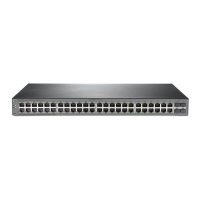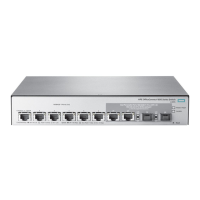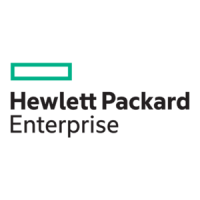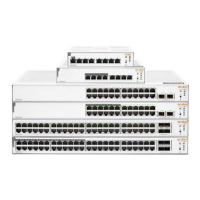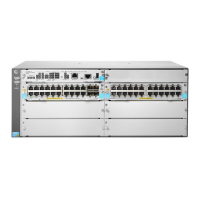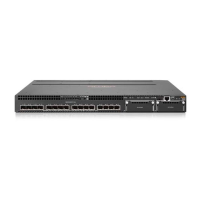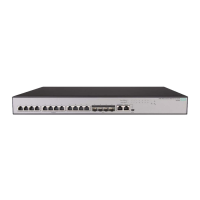
Do you have a question about the HPE OfficeConnect 1950 Series and is the answer not in the manual?
Guide on initial login procedures for the web interface.
Explains the structure and areas of the web interface.
Overview of the feature navigator menu for accessing device functions.
Instructions for managing the device using the Command Line Interface.
Rules and recommendations for a successful login to the web interface.
Specifies supported web browsers and necessary settings for web interface access.
Default credentials and settings for the initial login to the web interface.
Information on the maximum number of concurrent web interface users.
Procedures for securely logging out of the web interface.
Description of the banner and auxiliary section of the web interface.
Explanation of the navigation tree structure for accessing features.
Details on the content pane displaying information and configuration options.
Overview of different webpage types: feature, table, and configuration.
How to use feature pages to view and configure module functions.
How to use table pages to view and sort data entries.
How to use configuration pages for setting parameters and features.
Essential tasks for device configuration and management.
Methods to save the current device configuration settings.
Procedures for viewing and editing entries in data tables.
Steps required to restart the device for settings to take effect.
Overview of system status and logs provided by the dashboard.
Navigating tasks within the device management section.
Tools for testing network connectivity to devices.
Managing and configuring network interfaces on the device.
Bundling multiple physical links into a single logical aggregate link.
Configuring Virtual Local Area Networks for network segmentation.
Monitoring DHCP traffic to ensure security and proper IP assignment.
IP addressing and configuration settings for the device.
IPv6 addressing and configuration details.
Manually configuring static routes for network traffic forwarding.
Routing packets based on defined policies and criteria.
Configuring DHCP server and relay agent functions.
Secure Shell configuration for secure remote access and file transfer.
Access Control List configuration for traffic filtering and policy matching.
Public Key Infrastructure configuration for digital certificates.
Defining and applying QoS policies to manage traffic quality.
Configuring hardware queuing mechanisms for congestion management.
Mapping priority values to packets for scheduling and control.
Controlling traffic rates using token bucket mechanisms.
Configuring packet filters using Access Control Lists to control traffic flow.
Preventing IP spoofing by validating source IP and MAC address bindings.
Implementing 802.1X for port-based network access control.
Authenticating users based on their MAC addresses.
Enhancing network security by controlling MAC address learning and authentication.
Configuring basic device settings like name, location, and system time.
Configuring how the device obtains and maintains system time.
Managing administrator accounts, roles, and access permissions.
Setting the minimum length requirement for user passwords.
Defining rules for password complexity, including character types.
Enforcing policies to ensure user passwords are complex and secure.
Implementing password lifecycle management through expiration policies.
Understanding master and standby roles in an IRF stack.
Logical interfaces used for connecting stack member devices.
Unique identifier for a stack to prevent interference.
Concepts related to stack link failures and reunification.
Determining master election likelihood based on priority settings.
Bundling multiple Ethernet links into a single logical aggregate link.
Static and dynamic modes for operating aggregation groups.
Grouping VLAN members by port for network segmentation.
Virtual interfaces for Layer 3 communication between VLANs.
Configuring VLANs to prioritize voice traffic with QoS.
Automatic and manual methods for assigning ports to voice VLANs.
Different types of entries stored in the MAC address table.
Configuring timers for dynamic MAC address entries to manage table space.
Enabling or disabling MAC address learning to prevent table saturation.
Different modes for Spanning Tree Protocol: STP, RSTP, PVST, MSTP.
Fundamental concepts of Multiple Spanning Tree Protocol regions and instances.
Roles of ports in spanning tree calculation: root, designated, alternate, backup, master.
States of ports in RSTP and MSTP: Forwarding, Learning, Discarding.
Mapping of entities where LLDP runs on the network.
How LLDP agents send frames to connected devices.
How LLDP agents process received LLDP frames.
Notifying network management systems of LLDP events.
Classification of IPv4 addresses into classes A, B, C, D, and E.
Dividing networks into subnets and using subnet masks.
Methods to assign IP addresses to interfaces: manual or DHCP.
Maximum Transmission Unit configuration for network interfaces.
Dynamic and static ARP entries stored in the ARP table.
ARP entries created and updated automatically by the device.
Manually configured ARP entries for protecting IP-to-MAC mappings.
Features to detect and prevent ARP attacks on the network.
Updating ARP entries using information from gratuitous ARP packets.
Preventing gateway spoofing and ARP entry aging.
Using DNS server to resolve domain names to IP addresses.
Manually creating mappings between domain names and IP addresses.
Simplifying network management by forwarding DNS requests.
Dynamically updating domain name-to-IP address mappings for DNS servers.
Representation and simplification methods for IPv6 addresses.
Different types of IPv6 addresses: Unicast, Multicast, Anycast.
Generating interface identifiers from MAC addresses for IPv6.
Methods for configuring IPv6 global unicast addresses: EUI-64 or manual.
Methods for configuring IPv6 link-local addresses: automatic or manual.
Enabling devices to answer NS messages for hosts on other networks.
ND proxy behavior across different subnets.
ND proxy behavior within different VLANs.
Defining match criteria and actions for routing packets.
Integrating PBR with Track feature for dynamic action status adaptation.
Configuring the device as a DHCP server to assign IP addresses.
Defining IP address ranges and parameters for DHCP clients.
Carrying dynamic address allocation information and additional client configurations.
Recording client IP-MAC bindings for security functions.
Periodically refreshing DHCP relay entries for client information.
Management Information Base structure for network device variables.
Configuring SNMP access control using community names and ACLs.
Defining and applying QoS policies to manage traffic quality.
Defining criteria for classifying network traffic.
Defining QoS actions to be taken on classified traffic.
Methods to apply QoS policies to interfaces, VLANs, or globally.
Weighted Fair Queuing for proportional bandwidth allocation based on precedence.
Configuring port priority to influence packet scheduling and forwarding.
Steps to set port priority for incoming packets.
Configuring packet filters using Access Control Lists to control traffic flow.
Preventing IP spoofing by validating source IP and MAC address bindings.
General description of IP Source Guard functionality.
Manually configuring static IP Source Guard bindings for specific interfaces.
Implementing 802.1X for port-based network access control.
Components and entities involved in the 802.1X protocol.
EAP relay and EAP termination methods for RADIUS authentication.
Port-based and MAC-based access control methods defined by 802.1X.
Controlling network access based on port authorization status.
Reauthenticating users periodically to update authorization attributes.
Checking connectivity status of online 802.1X users.
Configuring a VLAN for users who fail 802.1X authentication.
Configuring a VLAN for users who have not performed 802.1X authentication.
Configuring a VLAN for users failing authentication due to unreachable RADIUS servers.
Placing users in a domain for unified authentication and authorization.
Controlling network access by authenticating source MAC addresses.
General overview of MAC authentication.
Combining 802.1X and MAC authentication for MAC-based access control.
Logging off users who fail ACL or user profile authorization.
Configuring timers for secure MAC addresses to age out.
Different security modes for port security: autoLearn, secure, authentication methods.
Modes for aging out secure MAC addresses: Timeout or Inactivity.
Specifying the maximum number of secure MAC addresses allowed on a port.
Receiving authentication requests and interacting with access devices.
Pushing authentication pages and forwarding user information.
Using the access device as both portal server and authentication server.
Allowing specified users to access external websites without portal authentication.
Configuring portal features on specific interfaces.
Remote Authentication Dial-In User Service protocol details.
Understanding the RADIUS client/server model and its use.
Additional RADIUS features supported by the device.
Classification of logs into eight severity levels.
Configuring where system logs are outputted: log buffer or log host.
Examples for maintaining device settings and configurations.
Example for configuring device system time synchronization with NTP.
Example for creating and configuring administrator accounts.
Example for configuring a virtual stack using IRF.
Example for configuring the device as an NTP server and client.
Example for configuring SNMP service and access control.
Example for configuring static Layer 2 link aggregation.
Example for configuring port isolation to isolate hosts.
Example for configuring VLANs to segment network traffic.
Example for enabling voice VLANs and configuring OUI addresses.
Example for configuring static and blackhole MAC address entries.
Example for configuring MSTP to forward VLAN traffic along different spanning trees.
Example for configuring LLDP on switches for neighbor discovery.
Example for configuring DHCP snooping to secure IP assignment.
Example for configuring static ARP entries to prevent spoofing.
Example for configuring static DNS entries for name resolution.
Example for configuring dynamic DNS for updating name-to-IP mappings.
Example for configuring DDNS with a specific service provider.
Example for configuring IPv6 addresses using EUI-64.
Example for configuring IPv6 Neighbor Discovery protocol.
Example for configuring local port mirroring for traffic monitoring.
Example for configuring static IPv4 routes for network communication.
Example for configuring Policy-Based Routing for IPv4 traffic.
Example for configuring IGMP snooping to manage multicast traffic.
Example for configuring MLD snooping to manage IPv6 multicast traffic.
Example for configuring DHCP server and relay agent.
Example for configuring QoS policies, queuing, and rate limiting.
Examples for configuring various security features.
Example for filtering traffic using ACLs with time-based rules.
Example for configuring static IPv4 Source Guard entries.
Example for configuring 802.1X authentication using a RADIUS server.
Example for configuring 802.1X authentication using local user accounts.
Example for configuring MAC authentication using RADIUS.
Example for configuring RADIUS-based port security with OUI matching.
Example for configuring direct portal authentication for host access.
Example for configuring re-DHCP portal authentication with private and public IPs.
Example for configuring cross-subnet portal authentication.
Example for configuring AAA for SSH users via TACACS server.
Example for configuring Power over Ethernet for IP phones and APs.
A summary of CLI commands for device management.
Explains conventions used in the documentation for clarity.
Explains conventions used for commands and syntax.
Explains conventions used for graphical user interface elements.
Explains the meaning of symbols used for alerts and notes.
Describes icons representing network devices and connections.
Information on how to access HPE support services and resources.
Guidance on how to find and download software updates.
Links to various Hewlett Packard Enterprise websites for networking and general information.
Information about Hewlett Packard Enterprise customer self repair programs.
Details on remote support services available for supported devices.
Instructions for providing feedback to improve documentation.
